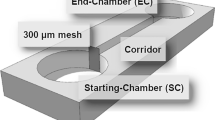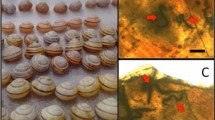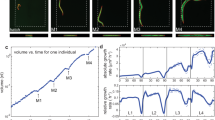Abstract
UNLIKE the morphological changes during the life cycle of many nematodes, the physiological processes of moulting, growth and development are poorly known for these animals. Some think that growth and development are less complex because after the first larval stage nematodes remain essentially cell constant1,2. Ultimate size, therefore, is normally reached by enlargement of cells and their modification rather than by an increase in numbers.
This is a preview of subscription content, access via your institution
Access options
Subscribe to this journal
Receive 51 print issues and online access
$199.00 per year
only $3.90 per issue
Buy this article
- Purchase on SpringerLink
- Instant access to full article PDF
Prices may be subject to local taxes which are calculated during checkout
Similar content being viewed by others
References
Hyman, L. H., The Invertebrates, 3, 259 (McGraw-Hill, 1951).
Lee, D. L., The Physiology of Nematodes, University Reviews in Biology, 154 (Freeman, San Francisco, 1965).
Wigglesworth, V. B., J. Insect. Physiol., 9, 105 (1963).
Meerovitch, E., Canad. J. Zool., 43, 81 (1964).
Evans, R. W., J. Clin. Pathol., 10, 31 (1957).
Pierce, G. B., and Dixon, F. J., Cancer, 12, 573 (1959).
Gurdon, J. B., Sci. Amer., 219, 24 (1968).
Author information
Authors and Affiliations
Rights and permissions
About this article
Cite this article
JOHNSON, R., VIGLIERCHIO, D. Induction of a Nematode Teratoma. Nature 227, 190–191 (1970). https://doi.org/10.1038/227190a0
Received:
Revised:
Issue date:
DOI: https://doi.org/10.1038/227190a0



